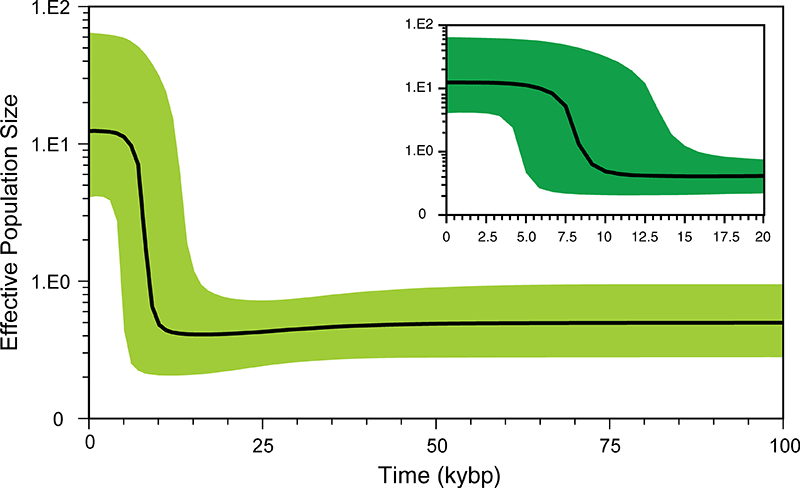Open access Origin and spread of Thoroughbred racehorses inferred from complete mitochondrial genome sequences: Phylogenomic and Bayesian coalescent perspectives, by Yoon et al. PLOS One (2018).
Abstract (emphasis mine)
The Thoroughbred horse breed was developed primarily for racing, and has a significant contribution to the qualitative improvement of many other horse breeds. Despite the importance of Thoroughbred racehorses in historical, cultural, and economical viewpoints, there was no temporal and spatial dynamics of them using the mitogenome sequences. To explore this topic, the complete mitochondrial genome sequences of 14 Thoroughbreds and two Przewalski’s horses were determined. These sequences were analyzed together along with 151 previously published horse mitochondrial genomes from a range of breeds across the globe using a Bayesian coalescent approach as well as Bayesian inference and maximum likelihood methods. The racing horses were revealed to have multiple maternal origins and to be closely related to horses from one Asian, two Middle Eastern, and five European breeds. Thoroughbred horse breed was not directly related to the Przewalski’s horse which has been regarded as the closest taxon to the all domestic horses and the only true wild horse species left in the world. Our phylogenomic analyses also supported that there was no apparent correlation between geographic origin or breed and the evolution of global horses. The most recent common ancestor of the Thoroughbreds lived approximately 8,100–111,500 years ago, which was significantly younger than the most recent common ancestor of modern horses (0.7286 My). Bayesian skyline plot revealed that the population expansion of modern horses, including Thoroughbreds, occurred approximately 5,500–11,000 years ago, which coincide with the start of domestication. This is the first phylogenomic study on the Thoroughbred racehorse in association with its spatio-temporal dynamics. The database and genetic history information of Thoroughbred mitogenomes obtained from the present study provide useful information for future horse improvement projects, as well as for the study of horse genomics, conservation, and in association with its geographical distribution.

The dark line in the BSP represents the estimated effective population size through time. The green area represents the 95% highest posterior density confidence intervals for this estimate.
Interesting excerpts:
We carried out a Bayesian coalescent approach using extended mitochondrial genome sequences from 167 horses in order to further assess the timescale of horse domestication. Here, we first calculated the time of the most recent common ancestor of Thoroughbred horses. Our analysis revealed the age of the most recent common ancestor of the racing horse to be around 8,100–111,500 years old. This estimate is much younger than that of the most recent common ancestor of the global horses, which has been estimated at 0.7286 Mys old.

The data set (16,432 base pairs) was also analyzed phylogenetically using Bayesian inference (BI) and maximum likelihood (ML) methods which showed the same topologies. 95% Highest Posterior Density of node heights are shown by blue bars. Groups are marked by a “G”. Numbers at the nodes represent (left to right): posterior probabilities (≥0.80) for the BI tree and bootstrap values (≥70%) for the ML tree. The racing horses were revealed to have multiple maternal origins and to be closely related to horses from one Asian, two Middle Eastern, and five European breeds. Results of phylogenomic analyses also uncovered no apparent association between geographic origin or breed and heterogeneity of global horses. The most recent common ancestor of the Thoroughbreds lived approximately 8,100–111,500 years ago, which was significantly younger than the most recent common ancestor of modern horses (0.7286 My).
On the domestication time of modern horses, there have been several publications derived from both archaeological [49–51] and molecular [11–12, 23, 48] evidences. D’Andrade [49] reported that the origin of domestic horses was around 4,000 years ago. Ludwig et al. [50] stated the domestication time to be about 5,000 years ago, while Anthony [51] noted that horse rearing by humans may have occurred approximately 6,000 years ago. Subsequently, on the basis of mitochondrial genome sequences, Lippold et al. [11] and Achilli et al. [12] postulated domestication time to be about 6,000–8,000 and 6,000–7,000 years ago, respectively. Warmuth [48] dated domestication time to 5,500 years ago based on autosomal genotype data, while Orlando et al. [23] claimed that Przewalski’s and domestic horse populations diverged 38,000–72,000 years ago based on analysis of genome sequences. In contrast to the previous hypothesized date of horse domestication, the results of our Bayesian skyline plot (BSP) analysis depict a rapid expansion of the horse population approximately 5,500–11,000 years ago, which coincides with the start of domestication.
It seems that we will not have an update on horse aDNA from the ISBA 8, so we will have to make do with this for the moment.
Lots of outstanding puzzles and cool new insights in Ludovic Orlando @LudovicLorlando’s (Twitter-embargoed) “Tracking six millennia of horse #selection, #admixture and management with complete genome time series” at #ISBA8 #domestication #aDNA pic.twitter.com/gP6Tam8wDc
— Alexander M. Kim (@amwkim) September 19, 2018
Related
- Origin of horse domestication likely on the North Caspian steppes
- Ancient DNA upends the horse family tree
- Domesticated horse population structure, selection, and mtDNA geographic patterns
- About Scepters, Horses, and War: on Khvalynsk migrants in the Caucasus and the Danube
- Steppe and Caucasus Eneolithic: the new keystones of the EHG-CHG-ANE ancestry in steppe groups
- Domestication spread probably via the North Pontic steppe to Khvalynsk… but not horse riding
- Differing modes of animal exploitation in North Pontic Eneolithic and Bronze Age Societies